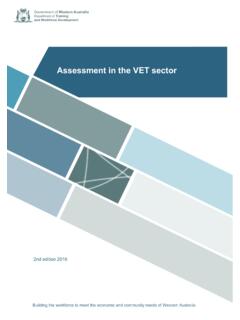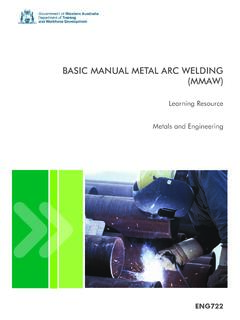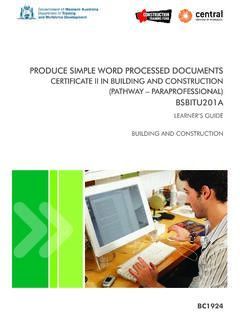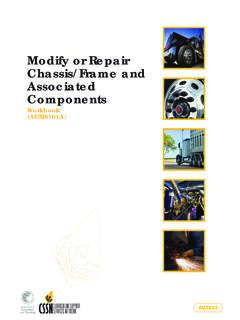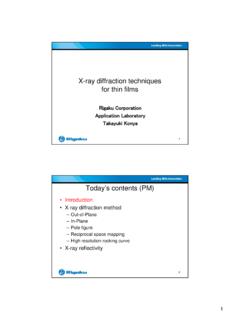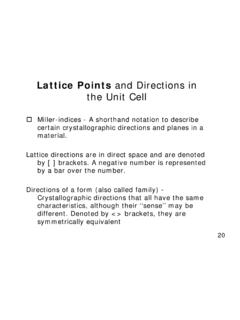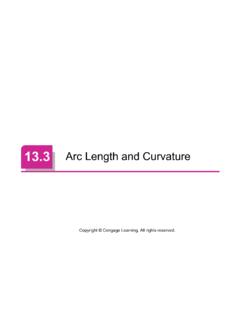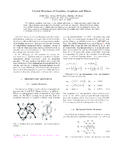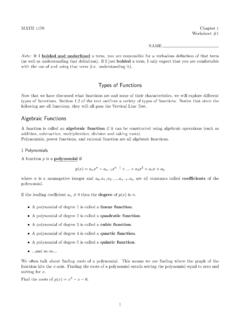Transcription of Fluid Mechanics - dtwd.wa.gov.au
1 Fluid Mechanics EA706 National Engineering Module EA706 Fluid Mechanics 1 Second Edition STUDENT WORKBOOK EA706 Fluid Mechanics 1 NATIONAL ENGINEERING MODULE Module Resource Notes Sections 1-6 Copyright and Terms of Use Department of Training and Workforce Development 2016 (unless indicated otherwise, for example Excluded Material ). The copyright material published in this product is subject to the Copyright Act 1968 (Cth), and is owned by the Department of Training and Workforce Development or, where indicated, by a party other than the Department of Training and Workforce Development. The Department of Training and Workforce Development supports and encourages use of its material for all legitimate purposes.
2 Copyright material available on this website is licensed under a Creative Commons Attribution (CC BY ) license unless indicated otherwise (Excluded Material). Except in relation to Excluded Material this license allows you to: Share copy and redistribute the material in any medium or format Adapt remix, transform, and build upon the material for any purpose, even commercially provided you attribute the Department of Training and Workforce Development as the source of the copyright material. The Department of Training and Workforce Development requests attribution as: Department of Training and Workforce Development (year of publication).
3 Excluded Material not available under a Creative Commons license: 1. The Department of Training and Workforce Development logo, other logos and trademark protected material; and 2. Material owned by third parties that has been reproduced with permission. Permission will need to be obtained from third parties to re-use their material. Excluded Material may not be licensed under a CC BY license and can only be used in accordance with the specific terms of use attached to that material or where permitted by the Copyright Act 1968 (Cth). If you want to use such material in a manner that is not covered by those specific terms of use, you must request permission from the copyright owner of the material.
4 If you have any questions regarding use of material available in this product, please contact the Department of Training and Workforce Development. Training Sector Services Telephone: 08 6212 9789 Email: Website: First published 1996 Revised January 2000 Second edition 2002 Developed by: Challenger TAFE ISBN 0 7307 2257 0 Challenger TAFE 2002 Notes prepared by Roger Watson All rights reserved. No part of this publication may be reproduced, stored in a retrieval system or transmitted in any form or by any means, electronic, mechanical, photocopying, recording or otherwise, without the prior written permission of Challenger TAFE. Whilst every effort has been made to ensure the accuracy of the information contained in this publication, no guarantee can be given that all errors and omissions have been excluded.
5 No responsibility for loss occasioned to any person acting or refraining from action as a result of the material in this publication can be accepted by Challenger TAFE. Published by and available from WestOne Services Prospect Place West Perth WA 6005 Tel: (08) 9229 5252 Fax: (08) 9229 5292 E-mail: Fluid Mechanics 1 Contents Introduction to the module Section 1: Basic Properties of Fluids Section 2: Components Section 3: Fluid Statics Section 4: Fluid Flow Section 5: Fluid Power Section 6: Forces Developed by Flowing Fluids Answers to Check Your Progress Laboratory Notes i ii EA706 Fluid Mechanics 1 Introduction to the module Welcome to EA706 Fluid Mechanics 1.
6 This module will assist you in developing skills that will be very useful in your engineering career. Fluid Mechanics 1 is a core unit in the Diplmoa and in the Advanced Diploma in Engineering (Mechanical stream). This module will make use of the knowledge gained during study of the prerequisite modules, EA003 Engineering Mathematics A and EA859 Statics. This module lays the foundations for future modules, such as EB720 Fluid Mechanics 2 or EA708 Industrial Fluid Power 1. Textbook There is no textbook for this module. The module notes are self-contained. References In addition to these notes, you may wish to obtain other reference material.
7 One good source of information is a TAFE Resource Centre, where books on Fluid Mechanics and Fluid power are stocked. A visit to any major bookshop will yield a selection of books dealing with Fluid Mechanics . Some good references are: Thermodynamics and Fluid Mechanics by Roger Kinsky Fluid Mechanics by Roger Kinsky Solving Problems in Fluid Mechanics Volume 1 by J Douglas Fluid Mechanics for Technologists by John Bugler Course Structure The course material is divided into six Sections; each section covers one learning outcome. Each learning outcome has a number of assessment criteria. These have been restated as specific objectives for you to achieve.
8 The objectives are presented to you in the following way. Information: This is learning material containing theory and examples. iii INTRODUCTION Practice exercises: These activities have answers that appear immediately after the exercises. Self Tests: Each test enables you to check your solutions with those at the end of the Section. You should do all the practice exercises and self tests in order to monitor your progress through the course. At the end of each section, you would normally undertake a competency test. The test would be assessed and, if acceptable, you were able to proceed to the next section. If the test was not acceptable, you should go back and restudy the current section.
9 Your lecturer will advise you regarding the format of the competency tests. Laboratory Work In addition to the six competencies, part of the requirements for Fluid Mechanics 1 is the participation in at least three laboratory experiments and submission of relevant reports. Your lecturer will advise you regarding the number and content of the formal laboratory work requirement. iv EA706 Fluid Mechanics 1 Section 1 Properties of Fluids LEARNING OUTCOME Describe the basic properties of fluids, quote applicable units and determine how these properties inter-relate to one another in Fluid applications. OBJECTIVES At the end of your study of this Section, you will be able to: describe the basic properties of fluids and units calculate one property given another (eg calculate mass given dimensions and relative density) draw a graph for a liquid showing typical variation of saturation vapour pressure with temperature describe the difference between real and ideal gases and liquids calculate the property changes to perfect gases using the gas laws or the characteristic gas equation.
10 Unit Fluid Definitions Matter can exist in three basic forms, either as a solid, a liquid or a gas Solids retain their shape and have no tendency to flow Liquids offer considerable resistance to compression, which is not greatly affected by changes in temperature. The reciprocal of the compressibility of a liquid is measured in newtons per square metre and called the bulk modulus, which may be likened to the modulus of elasticity of a material. As an indication of the low compressibility of water, its bulk modulus at 2 GPa is approximately one hundredth of the modulus of elasticity of steel. The reduction in volume of a liquid due to compression is so small that it is usually ignored.
